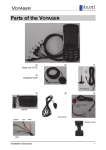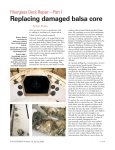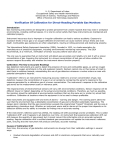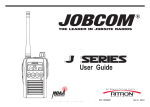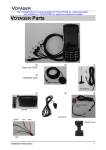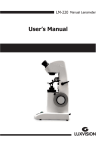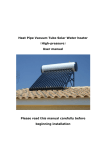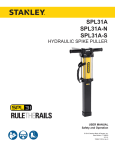Download Complete Vacuum Degassing System Operating
Transcript
easycomposites TM share the knowledge SETUP & DAILY USE INSTRUCTIONS Complete Vacuum Degassing System VP425 VP4300 1 CONTENTS 1. Introduction2 2. First Time Use - Setup Instructions3 Screw-in valve assembly3 Connect hose to pump3 Fill pump with oil4 Remove dust-cap from exhaust chimney5 2. First Time Use - Setup Instructions When you first receive your Easy Composites’ Complete Vacuum Degassing System, please follow these simple steps to assemble the system and prepare it for first use. Do NOT run the pump before you have followed these steps. 1. Screw in Valve Assembly First, screw the complete valve assembly into the threaded hole on the front of the degassing chamber. 3. Daily Operation6 Open vacuum pump valve6 Press down lid firmly6 Ensure inlet valve is closed6 Switch on vacuum pump7 Wait whilst the pressure drops7 Close the vacuum valve7 Switch off the vacuum pump8 Open the re-pressurising (inlet) valve8 Remove lid8 The assembly is already fitted with PTFE tape. If you need to remove and replace the valve assembly in the future, replace the PTFE tape to ensure an airtight seal. Rotate the assembly clockwise until it becomes tight, finishing with the gauge pointing vertically up. 2. Connect Hose to Pump 4. Operating Conditions & Maintenance9 The system is supplied with a 1.5m length of 8mm ID black silicone vacuum hose. 5. Warranty Information10 Push one end of the hose onto the hose-tail barb fitting on the vacuum pump and the other end onto the hose-tail barb fitting on the degassing chamber. 1. Introduction Thank you for choosing to buy our Easy Composites’ Complete Vacuum Degassing System. The degassing chamber itself is expertly manufactured by Easy Composites Ltd in the UK from high quality materials and to our uniquely practical and effective design. The vacuum pumps are manufactured specifically for us and have proved themselves to be very reliable pumps for daily use. If used and maintained correctly, both the pump and chamber will provide years of trouble free service. Please read the following instructions BEFORE USE to familiarise yourself with the setup and daily operation of the system. 2 Contents / Introduction First Time Use / Valve Assembly / Connect Hose to Pump 3 3. Fill Pump with Oil 4. Remove Dust Cap To avoid leakage during transport, our vacuum pumps are supplied without any vacuum oil in them. They need to be filled to the correct level using the supplied Vacuum Pump Oil before use. If you have not already done so, before switching the pump on, be sure to remove the rubber dust-cap from the exhaust chimney. Follow the instructions below according to the model of vacuum pump included with your degassing system. The rubber cap can be left off the pump in future or replaced for longer term storage. Vacuum Pump VP425 Vacuum Pump VP4300 5. Set Voltage (If Required) 220 Unscrew the black plastic chimney from the top of the vacuum pump (on the end with the oil sight-gauge). Unscrew the red oil filler cap near the base of the pump’s carrying handle. 220 110 The VP425 and VP4300 have a switch-able power supply mode so that they can be used on both 230V mains supply (UK, Europe, Australasia, China etc.) and 110V (USA, Canada, Japan etc.). When shipped, the pump will be set to 230v. If you will be using the pump in a country where the mains supply is 110v then please slide the voltage setting on the pump before switching it on. 6. Open Valve on Pump FILL TO HERE Fill the vacuum pump with oil until the oil level is halfway up the sight-gauge on the end of the pump. Be aware that it might take a few moments for the oil to work its way down into the pump. 4 FILL TO HERE Fill the vacuum pump with oil until the oil level is halfway up the sight-gauge on the end of the pump. Be aware that it might take a few moments for the oil to work its way down into the pump. When using the pump with your degassing chamber, it is suggested to leave the valve on the pump permanently in the OPEN position and instead use the valve on the chamber itself. If you overfill the pump, you can use the oil-drain screw towards the base of the pump to remove some oil. First Time Use / Fill Pump with Oil First Time Use / Remove Dust Cap / Set Voltage / Open Valve 5 3. Daily Operation 1. Load Material 5. Switch Pump On 6. Wait for Degassing 2. Press-down Lid Firmly -30 Turn the vacuum pump on using the power switch on the pump. Start by removing the acrylic lid and loading your material (casting resin, RTV silicone rubber) into the degassing chamber. 3. Check Inlet is Closed Press down firmly on the lid to make sure it is well seated into the seal. At this point you may need to press lightly on the lid to make the intial vacuum seal. Wait whilst the pressure drops inside the vacuum chamber. Using the smaller VP425 pumps this will take around 4 minutes. Using the larger VP4300 pump this will take around 1 minute 30 seconds. Degassing Times As the pressure in the chamber, shown on the vacuum gauge, approaches -1 bar (30in Hg), any air trapped in the material will expand and start to bubble out of it. 4. Open Vacuum Valve RTV silicones in particular will expand considerably whilst this happens. With silicones, there will come a point where the material collapses down again. This is a good indication that the degassing process is complete. Once no air bubbles or only very occasional air bubbles are rising out of the material proceed with the following close and re-pressurise steps. 7. Close Vacuum Valve ALWAYS CLOSE THE VACUUM VALVE BEFORE SWITCHING OFF THE PUMP. Make sure the inlet valve (which has the brass filter fitted) is in the closed position, especially if you have just run a degassing operation. Open the vacuum valve on the chamber which connects it to the vacuum pump by turning it to the horizontal position. The valve is closed when this leaver is facing upwards. 6 Daily Operation / Load Material / Press Down Lid / Close Inlet Close the vacuum valve that connects the chamber to the vacuum pump. Failure to do this before switching off the vacuum pump will cause air and oil to be sucked back through the pump causing certain damage to the pump and contamination of the degassed material. Daily Operation / Switch Pump On / Wait for Pressure to Drop 7 4. Operating Conditions & Maintenance 8. Switch off Pump Once the vacuum valve has been firmly closed, the vacuum pump can be switched off. Never switch off the vacuum pump with the vacuum valve which connects it to the chamber is open (see notes on previous page). The Easy Composites Complete Vacuum Degassing System is designed to provide years of reliable service however it is very important to ensure that you’re using the system in an appropriate environment and maintaining it properly; failure to do so will shorten the life of the system and invalidate the warranty. Please read and follow these important points on operating conditions and maintenance: Do... Don’t... Regularly check the oil level in the pump and top-up as necessary. 9. Open Inlet Valve To let air back into the chamber, turn the re-pressuring (inlet) valve on the degassing chamber counter-clockwise into the horizontal position. The inlet port is fitted with a ‘soft’ filter to restrict the rate at which air re-enters the chamber, helping to avoid disturbing materials inside or contaminating them with dust and other particles. The filter can be adjusted to change the amount of restriction, as required. Never use the system on the floor. If oil appears contaminated (cloudy), empty it from the pump and replace it with fresh vacuum pump oil. Never operate the pump in dusty conditions. Dust particles will be drawn into the pump and will contaminate the oil and accelerate wear. Use the system in a clean, dry environment and in an elevated position such as on a workbench or counter-top. Don’t use the system as a vacuum dryer. Moisture extracted from damp materials such as wood or plaster will emulsify the oil. Keep the system clean using a damp cloth and soapy water. Never use anything other than High Vacuum – Pump Oil to top-up your vacuum pump. Make sure all fittings are properly sealed. Use PTFE to seal and fittings you need to adjust or re-fit. Never use solvents to clean the pump or chamber, particularly the acrylic lid. 10. Remove Lid Once air can no longer be heard passing through the filter the chamber will be back up to normal atmospheric pressure. Once this has happened, lift the lid off the chamber to remove your degassed material. 8 Daily Operation / Switch off Pump / Open Inlet / Remove Lid Operating Conditions & Maintenance 9 5. Warranty Easy Composites Ltd warrants that this Complete Vacuum Degassing System will be free from defects in materials and workmanship for a period of 12 months from the date of purchase. Should a failure occur within this period, Easy Composites Ltd will repair or replace any defective part of the system on a like-for-like basis. This limited warranty does not cover damage to the system caused by misuse, improper maintenance or use not in accordance with these instructions. In circumstances of very frequent use it is quite possible for the vanes on the vacuum pump to wear-out, indicated by reduced vacuum levels being achieved. This is normal wear-and-tear and not covered by the warranty. Replacement vanes can be supplied to renew the pump and restore the vacuum level. Easy Composites Ltd is not liable for, and does not cover under warranty, any damages or losses of any kind whatsoever resulting from failure of this product. In the event of a claim, Easy Composites Ltd’s sole obligation shall be to issue a refund or replacement of the product itself. 10 Warranty 11 Expert materials, equipment and training for advanced composites. Casting Equipment & Materials Wide range of casting resins Filler powders and additives Metal powders for cold casting RTV silicone rubber Pigments and tints Degassing chambers, vacuum pumps and complete degassing systems Casting ancillaries Advanced Composites Benchtop curing ovens Huge range of reinforcement fabrics, braids and tapes Carbon fibre sheet, tube and sections Vacuum bagging / infusion consumables Prepreg equipment and materials Pattern and mould making materials Core materials Epoxy, polyester and vinylester resins Starter kits for advanced processes Training courses WWW.EASYCOMPOSITES.CO.UK Easy Composites Ltd. Unit 39, Park Hall Business Village, Longton, Stoke on Trent, Staffordshire, ST3 5XA. United Kingdom. Tel. +44 (0)1782 454499 | Fax. +44 (0)1782 596868 | [email protected]








